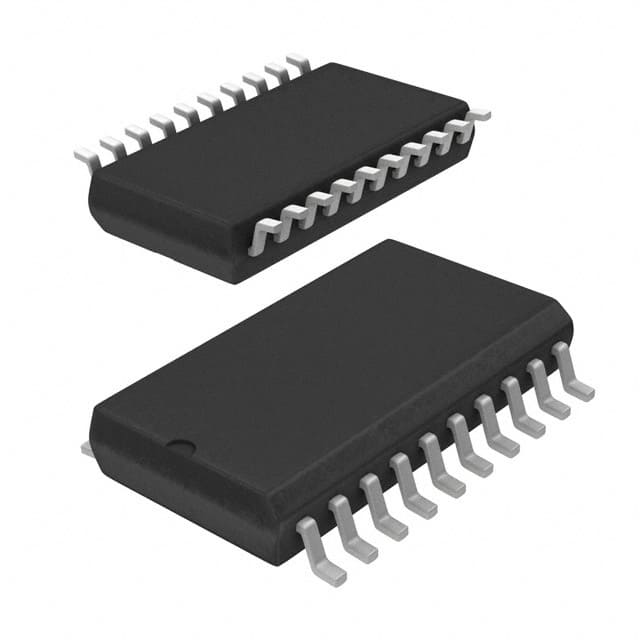Viz Specifikace pro podrobnosti o produktu.

MC74ACT245MELG
Product Overview
- Category: Integrated Circuit
- Use: Signal Level Shifter
- Characteristics: High-Speed, Non-Inverting, Octal Bus Transceiver
- Package: SOIC (Small Outline Integrated Circuit)
- Essence: Transfers data between two bidirectional bus systems operating at different voltage levels
- Packaging/Quantity: Tape and Reel, 2500 units per reel
Specifications
- Logic Family: ACT
- Number of Channels: 8
- Input Voltage Range: 2.0V to 6.0V
- Output Voltage Range: 2.0V to 6.0V
- Propagation Delay: 7ns (typical)
- Operating Temperature Range: -40°C to +85°C
Detailed Pin Configuration
- A1: Channel 1 Data Input/Output
- B1: Channel 2 Data Input/Output
- GND: Ground
- A2: Channel 3 Data Input/Output
- B2: Channel 4 Data Input/Output
- VCC: Power Supply
- B3: Channel 5 Data Input/Output
- A3: Channel 6 Data Input/Output
- OE: Output Enable
- DIR: Direction Control
- B4: Channel 7 Data Input/Output
- A4: Channel 8 Data Input/Output
Functional Features
- Bidirectional data transfer between two buses with different voltage levels
- Non-inverting logic ensures the same polarity of data on both sides
- High-speed operation for efficient data transmission
- Output enable and direction control for flexible control over data flow
Advantages and Disadvantages
Advantages: - Allows interfacing between different voltage level systems - Non-inverting logic preserves data integrity - High-speed operation for quick data transfer
Disadvantages: - Limited to 8 channels, may not be suitable for applications requiring more channels - Requires careful consideration of voltage compatibility between the two bus systems
Working Principles
The MC74ACT245MELG is an octal bus transceiver designed to facilitate data transfer between two bidirectional bus systems operating at different voltage levels. It employs non-inverting logic, ensuring that the polarity of the data remains the same on both sides.
The device features a direction control pin (DIR) that determines the direction of data flow and an output enable pin (OE) that enables or disables the outputs. By controlling these pins, the user can regulate the data transfer between the two buses.
When the DIR pin is set to transmit mode, data from the A-side is transferred to the B-side, and vice versa when in receive mode. The OE pin allows the user to enable or disable the outputs, providing flexibility in controlling the data flow.
Detailed Application Field Plans
The MC74ACT245MELG is commonly used in various applications where there is a need to interface between two bus systems operating at different voltage levels. Some typical application fields include:
- Microcontroller interfacing with external memory modules
- Communication interfaces between different devices with varying voltage requirements
- Level shifting in mixed-signal circuit designs
- Data transfer between different logic families
Detailed and Complete Alternative Models
- SN74ACT245: Similar octal bus transceiver from Texas Instruments
- CD74ACT245: Octal non-inverting bus transceiver from Texas Instruments
- 74HCT245: Octal bus transceiver with voltage level translation from NXP Semiconductors
These alternative models offer similar functionality and can be considered as substitutes for the MC74ACT245MELG based on specific application requirements.
Word count: 411 words
Seznam 10 běžných otázek a odpovědí souvisejících s aplikací MC74ACT245MELG v technických řešeních
Sure! Here are 10 common questions and answers related to the application of MC74ACT245MELG in technical solutions:
Question: What is MC74ACT245MELG?
Answer: MC74ACT245MELG is a type of octal bus transceiver that can be used for bidirectional data transfer between different voltage levels.Question: What is the operating voltage range of MC74ACT245MELG?
Answer: The operating voltage range of MC74ACT245MELG is typically between 4.5V and 5.5V.Question: Can MC74ACT245MELG be used for level shifting?
Answer: Yes, MC74ACT245MELG can be used for level shifting as it supports bidirectional data transfer between different voltage levels.Question: How many data lines can MC74ACT245MELG handle?
Answer: MC74ACT245MELG can handle up to 8 data lines, making it suitable for applications requiring multiple data transfers.Question: What is the maximum data transfer rate supported by MC74ACT245MELG?
Answer: MC74ACT245MELG supports high-speed data transfer with a maximum frequency of 125 MHz.Question: Can MC74ACT245MELG be used in both parallel and serial communication systems?
Answer: Yes, MC74ACT245MELG can be used in both parallel and serial communication systems, depending on the application requirements.Question: Does MC74ACT245MELG have any built-in protection features?
Answer: Yes, MC74ACT245MELG has built-in ESD protection features to safeguard against electrostatic discharge.Question: What is the power supply current consumption of MC74ACT245MELG?
Answer: The power supply current consumption of MC74ACT245MELG is typically around 10 mA.Question: Can MC74ACT245MELG be used in automotive applications?
Answer: Yes, MC74ACT245MELG is suitable for automotive applications as it meets the necessary standards and specifications.Question: Are there any specific layout considerations for using MC74ACT245MELG?
Answer: Yes, it is recommended to follow the layout guidelines provided in the datasheet to ensure optimal performance and minimize signal integrity issues.
Please note that these answers are general and may vary depending on the specific application and requirements. It is always advisable to refer to the datasheet and consult with technical experts for accurate information.

